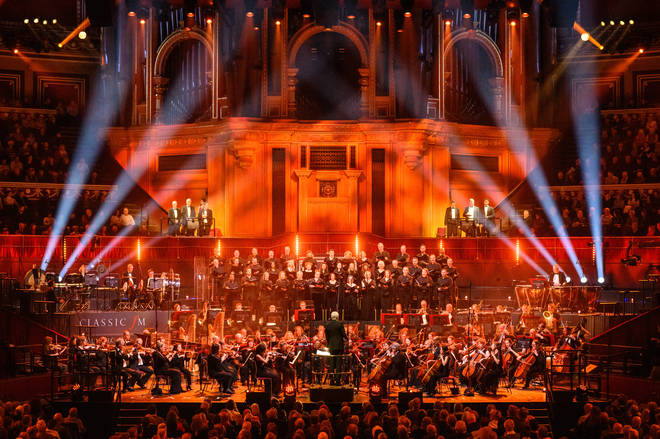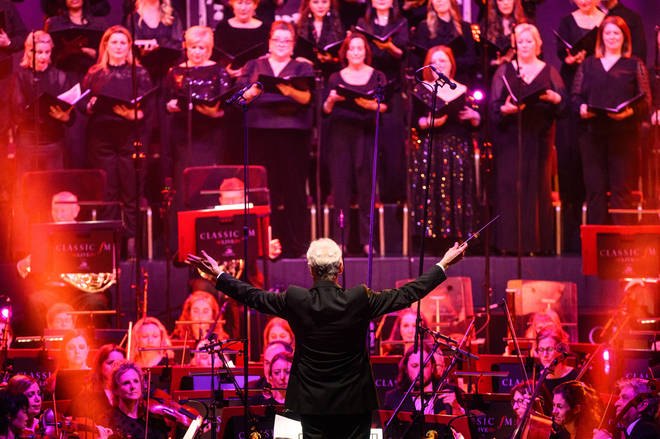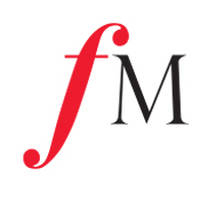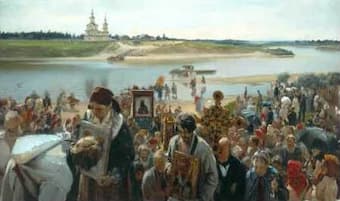Leopold Anthony Stokowski (18 April 1882 – 13 September 1977) was a British conductor. One of the leading conductors of the early and mid-20th century, he is best known for his long association with the Philadelphia Orchestra and his appearance in the Disney film Fantasia with that orchestra. He was especially noted for his free-hand conducting style that spurned the traditional baton and for obtaining a characteristically sumptuous sound from the orchestras he directed.
Stokowski was music director of the Cincinnati Symphony Orchestra, the Philadelphia Orchestra, the NBC Symphony Orchestra, New York Philharmonic Symphony Orchestra, the Houston Symphony Orchestra, the Symphony of the Air and many others. He was also the founder of the All-American Youth Orchestra, the New York City Symphony, the Hollywood Bowl Symphony Orchestra and the American Symphony Orchestra.
Stokowski conducted the music for and appeared in several Hollywood films, most notably Disney's Fantasia, and was a lifelong champion of contemporary composers, giving many premieres of new music during his 60-year conducting career. Stokowski, who made his official conducting debut in 1909, appeared in public for the last time in 1975 but continued making recordings until June 1977, a few months before his death at the age of 95.
Biography
Early life
The son of an English-born cabinet-maker of Polish heritage, Kopernik Joseph Boleslaw Stokowski, and his Northampton-born wife Annie-Marion (née Moore), Stokowski was born Leopold Anthony Stokowski, although on occasion in later life he altered his middle name to Antoni, per the Polish spelling. There is some mystery surrounding his early life. For example, he spoke with an unusual, non-British accent, though he was born and raised in London. On occasion, Stokowski gave his year of birth as 1887 instead of 1882, as in a letter to the Hugo Riemann Musiklexicon in 1950, which also incorrectly gave his birthplace as Kraków. Nicolas Slonimsky, editor of Baker's Biographical Dictionary of Musicians, received a letter from a Finnish encyclopaedia editor that said, "The Maestro himself told me that he was born in Pomerania, Germany, in 1889." In Germany there was a corresponding rumour that his original name was simply "Stock" (German for stick). However, Stokowski's birth certificate (signed by J. Claxton, the registrar at the General Office, Somerset House, London, in the parish of All Souls, County of Middlesex) gives his birth on 18 April 1882, at 13 Upper Marylebone Street (now New Cavendish Street), in the Marylebone District of London. Stokowski was named after his Polish-born grandfather Leopold, who died in the English county of Surrey on 13 January 1879, at the age of 49.
The mystery surrounding his origins and accent is clarified in Oliver Daniel's 1000-page biography Stokowski – A Counterpoint of View (1982), in which (in Chapter 12) Daniel reveals Stokowski came under the influence of his first wife, American pianist Olga Samaroff. Samaroff, born Lucy Mary Agnes Hickenlooper, was from Galveston, Texas, and adopted a more exotic-sounding name to further her career. For professional and career reasons, she "urged him to emphasize only the Polish part of his background" once he became a resident of the United States. He studied at the Royal College of Music, where he first enrolled in 1896 at the age of thirteen, making him one of the youngest students to do so. In his later life in the United States, Stokowski would perform six of the nine symphonies composed by his fellow organ student Ralph Vaughan Williams. Stokowski sang in the choir of the St Marylebone Parish Church, and later he became the assistant organist to Sir Walford Davies at The Temple Church. By age 16, Stokowski was elected to membership of the Royal College of Organists. In 1900, he formed the choir of St. Mary's Church, Charing Cross Road, where he trained the choirboys and played the organ. In 1902, he was appointed the organist and choir director of St. James's Church, Piccadilly. He also attended The Queen's College, Oxford, where he earned a Bachelor of Music degree in 1903.
New York, Paris, and Cincinnati
In 1905, Stokowski began work in New York City as the organist and choir director of St. Bartholomew's Church. He was very popular among the parishioners, who included members of the Vanderbilt family, but in the course of time, he resigned this position in order to pursue a career as an orchestra conductor. Stokowski moved to Paris for additional study in conducting. There he heard that the Cincinnati Symphony Orchestra would be needing a new conductor when it returned from a long sabbatical. In 1908, Stokowski began a campaign to win this position, writing letters to Mrs. Christian R. Holmes, the orchestra's president, and travelling to Cincinnati, Ohio, for a personal interview.
Stokowski was selected over other applicants and took up his conducting duties in late 1909. That was also the year of his official conducting debut in Paris with the Colonne Orchestra on 12 May 1909, when Stokowski accompanied his bride to be, the pianist Olga Samaroff, in Tchaikovsky's Piano Concerto No. 1. Stokowski's conducting debut in London took place the following week on 18 May with the New Symphony Orchestra at Queen's Hall. His engagement as new permanent conductor in Cincinnati was a great success. He introduced the concept of "pops concerts" and, starting with his first season, he began championing the work of living composers. His concerts included performances of music by Richard Strauss, Sibelius, Rachmaninoff, Debussy, Glazunov, Saint-Saëns and many others. He conducted the American premieres of new works by such composers as Elgar, whose 2nd Symphony was first presented there on 24 November 1911. He was to maintain his advocacy of contemporary music to the end of his career. However, in early 1912, Stokowski became frustrated with the politics of the orchestra's Board of Directors, and submitted his resignation. There was some dispute over whether to accept this or not, but, on 12 April 1912, the board decided to do so.[citation needed]
Philadelphia Orchestra
Leopold Stokowski historical marker at 240 S. Broad St., Philadelphia
Two months later, Stokowski was appointed the director of the Philadelphia Orchestra, and he made his conducting debut in Philadelphia on 11 October 1912. This position would bring him some of his greatest accomplishments and recognition. It has been suggested that Stokowski resigned abruptly at Cincinnati with the hidden knowledge that the conducting position in Philadelphia was his when he wanted it, or as Oscar Levant suggested in his book A Smattering of Ignorance, "he had the contract in his back pocket." Before Stokowski moved into his conducting position in Philadelphia, however, he returned to England to conduct two concerts at the Queen's Hall in London. On 22 May 1912, Stokowski conducted the London Symphony Orchestra in a concert that he was to repeat in its entirety 60 years later at the age of 90, and on 14 June 1912, he conducted an all-Wagner concert that featured the noted soprano Lillian Nordica. While he was director of the Philadelphia Orchestra, he was largely responsible for convincing Mary Louise Curtis Bok to set up the Curtis Institute of Music (13 October 1924) in Philadelphia. He helped with recruiting faculty and hired many of their graduates.[citation needed]
Stokowski rapidly gained a reputation as a musical showman. His flair for the theatrical included grand gestures, such as throwing the sheet music on the floor to show he did not need to conduct from a score. He also experimented with new lighting arrangements in the concert hall, at one point conducting in a dark hall with only his head and hands lighted, at other times arranging the lights so they would cast theatrical shadows of his head and hands. Late in the 1929-1930 symphony season, Stokowski started conducting without a baton. His free-hand manner of conducting soon became one of his trademarks. On the musical side, Stokowski nurtured the orchestra and shaped the "Stokowski" sound, or what became known as the "Philadelphia Sound".He encouraged "free bowing" from the string section, "free breathing" from the brass section, and continually altered the seating arrangements of the orchestra's sections, as well as the acoustics of the hall, in response to his urge to create a better sound. Stokowski is credited as the first conductor to adopt the seating plan that is used by most orchestras today, with first and second violins together on the conductor's left, and the violas and cellos to the right
Stokowski and the Philadelphia Orchestra at 2 March 1916 American premiere of Mahler's 8th Symphony
Stokowski also became known for modifying the orchestrations of some of the works that he conducted, as was a standard practice for conductors prior to the second half of the 20th century. Among others, he amended the orchestrations of Beethoven, Tchaikovsky, Sibelius, Johann Sebastian Bach, and Brahms. For example, Stokowski revised the ending of the Romeo and Juliet Fantasy Overture, by Tchaikovsky, so it would close quietly, taking his notion from Modest Tchaikovsky's Life and Letters of Peter Ilych Tchaikovsky (translated by Rosa Newmarch: 1906) that the composer had provided a quiet ending of his own at Balakirev's suggestion. Stokowski made his own orchestration of Mussorgsky's Night on Bald Mountain by adapting Rimsky-Korsakov's orchestration and making it sound, in some places, similar to Mussorgsky's original. In the film Fantasia, to conform to the Disney artists' story-line, depicting the battle between good and evil, the ending of Night on Bald Mountain segued into the beginning of Schubert's Ave Maria.
Many music critics have taken exception to the liberties Stokowski took—liberties which were common in the nineteenth century, but had mostly died out in the twentieth, when faithful adherence to the composer's scores became more common
Stokowski's repertoire was broad and included many contemporary works. He was the only conductor to perform all of Arnold Schoenberg's orchestral works during the composer's own lifetime, several of which were world premieres. Stokowski gave the first American performance of Schoenberg's Gurre-Lieder in 1932. It was recorded "live" on 78 rpm records and remained the only recording of this work in the catalogue until the advent of the LP Record. Stokowski also presented the American premieres of four of Dmitri Shostakovich's symphonies, Numbers 1, 3, 6, and 11. In 1916, Stokowski conducted the American premiere of Mahler's 8th Symphony, Symphony of a Thousand, whose premiere he had attended in Munich on 12 September, 1910[10] He added works by Rachmaninoff to his repertoire, giving the world premieres of his Fourth Piano Concerto, the Three Russian Songs, the Third Symphony, and the Rhapsody on a Theme of Paganini; Sibelius, whose last three symphonies were given their American premieres in Philadelphia in the 1920s; and Igor Stravinsky, many of whose works were also given their first American performances by Stokowski. In 1922, he introduced Stravinsky's score for the ballet The Rite of Spring to America, gave its first staged performance there in 1930 with Martha Graham dancing the part of The Chosen One, and at the same time made the first American recording of the work.[citation needed]
Seldom an opera conductor, Stokowski did give the American premieres in Philadelphia of the original version of Mussorgky's Boris Godunov (1929) and Alban Berg's Wozzeck (1931). Works by such composers as Arthur Bliss, Max Bruch, Ferruccio Busoni, Carlos Chávez, Aaron Copland, George Enescu, Manuel de Falla, Paul Hindemith, Gustav Holst, Gian Francesco Malipiero, Nikolai Myaskovsky, Walter Piston, Francis Poulenc, Sergei Prokofiev, Maurice Ravel, Ottorino Respighi, Albert Roussel, Alexander Scriabin, Elie Siegmeister, Karol Szymanowski, Edgard Varèse, Heitor Villa-Lobos, Anton Webern, and Kurt Weill, received their American premieres under Stokowski's direction in Philadelphia. In 1933, he started "Youth Concerts" for younger audiences, which are still a tradition in Philadelphia and many other American cities, and fostered youth music programs. After disputes with the board, Stokowski began to withdraw from involvement in the Philadelphia Orchestra from 1936 onwards, allowing his co-conductor Eugene Ormandy to gradually take over. Stokowski shared principal conducting duties with Ormandy from 1936 to 1941; Stokowski did not appear with the Philadelphia Orchestra from the closing concert of the 1940–41 season (a semi-disastrous performance of Bach's St. Matthew Passion) until 12 February 1960, when he guest-conducted the Philadelphia in works of Mozart, Falla, Respighi, and in a legendary performance of the Shostakovich Fifth Symphony, arguably the greatest by Stokowski. The recording of this concert's broadcast had been circulated privately among collectors over the years, though never issued commercially, but with the copyright expiring at the start of 2011, it was released in its entirety on the Pristine Audio label.[citation needed]
Stokowski appeared as himself in the motion picture The Big Broadcast of 1937, conducting two of his Bach transcriptions. That same year he also conducted and acted in One Hundred Men and a Girl, with Deanna Durbin and Adolphe Menjou. In 1939, Stokowski collaborated with Walt Disney to create the motion picture for which he is best known: Fantasia. He conducted all the music (with the exception of a "jam session" in the middle of the film) and included his own orchestrations for Bach's Toccata and Fugue in D minor and Mussorgsky's/Schubert's Night on Bald Mountain/Ave Maria. Stokowski even got to talk to (and shake hands with) Mickey Mouse on screen, in a famous silhouette footage; though, he would later say with a smile that Mickey Mouse got to shake hands with him.
A lifelong and ardent fan of the newest and most experimental techniques in recording, Stokowski saw to it that most of the music for Fantasia was recorded over Class A telephone lines laid down between the Academy of Music in Philadelphia and Bell Laboratories in Camden NJ, using an early, highly complex version of multi-track stereophonic sound, dubbed Fantasound, which shared many attributes with the later Perspecta stereophonic sound system. Recorded on photographic film, the only suitable medium then available, the results were considered astounding for the latter half of the 1930s.
Upon his return in 1960, Stokowski appeared with the Philadelphia Orchestra as a guest conductor. He also made two LP recordings with them for Columbia Records, one including a performance of Manuel de Falla's El amor brujo, which he had introduced to America in 1922 and had previously recorded for RCA Victor with the Hollywood Bowl Symphony Orchestra in 1946, and a Bach album which featured the 5th Brandenburg Concerto and three of his own Bach transcriptions. He continued to appear as a guest conductor on several more occasions, his final Philadelphia Orchestra concert taking place in 1969.
In honor of Stokowski's vast influence on music and the Philadelphia performing arts community, on 24 February 1969, he was awarded the prestigious University of Pennsylvania Glee Club Award of Merit. Beginning in 1964, this award was "established to bring a declaration of appreciation to an individual each year that has made a significant contribution to the world of music and helped to create a climate in which our talents may find valid expression."[citation needed]





















 Pandemics come and pandemics go, but Easter will surely return every year. For many Christians around the world this is the most important holiday of the year. It commemorates the Passion of Christ, starting with the Last Supper and culminating with the crucifixion and death of Jesus. But above all, it celebrates the resurrection of Jesus Christ. The time around Easter, in many cultures and in different parts of the world is connected with a sense of renewal. Hurrah, Spring is finally coming!
Pandemics come and pandemics go, but Easter will surely return every year. For many Christians around the world this is the most important holiday of the year. It commemorates the Passion of Christ, starting with the Last Supper and culminating with the crucifixion and death of Jesus. But above all, it celebrates the resurrection of Jesus Christ. The time around Easter, in many cultures and in different parts of the world is connected with a sense of renewal. Hurrah, Spring is finally coming!








